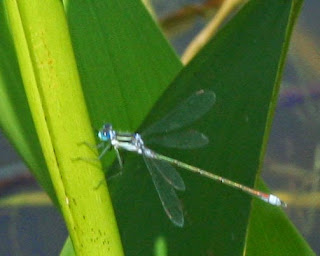(From July 2014
Facebook Note)
Hip high
waders, long-handled net and a small plastic spoon to scoop them from net to a
holding tub (can't touch them) and me slogging through muck.
 |
| Dragonfly Team: Ranger Michael, me, Julie and James |
And getting
STUCK - suction that wouldn't release my boot -
my co-"scientists" - Julie and James worked very hard to get
me unstuck as Ranger Michael was at the far end of the pond. We all ended up
falling down in the muck.
 |
| Aeshnidae, Libellulidae, and Gomphidae larvae (NPS) |
We captured 60
larvae and identified at least three different families. We also scooped up a
leech, a salt water clam (? fresh water pond?), caddis fly egg cases, a snail,
back-swimmers and either a moss animal or an egg mass of some kind.
(I don't remember which is which!)
The toxic form
of mercury, methylmercury, increases in concentration in the food chain. (NPS)
Excerpt from
study
Why use dragonfly larvae?
Dragonfly
larvae live in the water for 1-4 years or more before becoming adult
dragonflies. Aquatic systems like lakes, ponds, and wetlands are often where
methylmercury (the more toxic form that gets into living things) accumulates.
Dragonfly
larvae also eat small fish, tadpoles, and bugs that in turn contain
methylmercury. As the dragonfly larvae eat more, the amount of methylmercury in
their bodies increase in a process called bioaccumulation. When other animals,
such as larger fish, eat the dragonfly larvae these animals also accumulate
methlymercury, but at higher concentrations due to biomagnification up the food
chain. Dragonfly larvae are abundant and they are found across the country.
They are in the middle of the food chain, so they are potentially useful for determining
the health of an ecosystem.
Visit the University of Maine Facebook page Six-Legged Scouts in National Parks/About to find out more about this project.
# # #
Check out the Herb Sampler description on this Blog
SPECIAL Price reduction on Amazon. Click here.








No comments:
Post a Comment